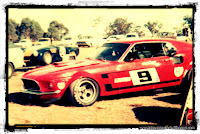"It was about eight minutes to six when the balloon quitted her moorings, and in twenty minutes she had become a mere speck, a homeopathic globule in the far distance, serenely and steadily sailing onwards, as though native to and rejoicing in the buoyant element." - Melbourne Argus 2nd February 1858
 The above newspaper report describes the first manned balloon flight in Australia which occurred in Melbourne the previous day, 1st February 1858. The new fangled flying machine was piloted by Mr Joseph Dean in a gas-powered balloon 'Australasian', imported and own by Mr George Coppin. The balloon which rose to a height of 3,000ft (915 metres) and lasted for about half an hour, landed safely on Heidelberg Road was watched by thousands of spectators crammed around Cremorne Gardens.
The above newspaper report describes the first manned balloon flight in Australia which occurred in Melbourne the previous day, 1st February 1858. The new fangled flying machine was piloted by Mr Joseph Dean in a gas-powered balloon 'Australasian', imported and own by Mr George Coppin. The balloon which rose to a height of 3,000ft (915 metres) and lasted for about half an hour, landed safely on Heidelberg Road was watched by thousands of spectators crammed around Cremorne Gardens.
This was such an important event in Melbourne society that even a special medal was struck to commemorate this outstanding achievement.
Even though ballooning has now been occurring in Australia for over 150 years, when you come across these beautiful machines ,it can still be as awe inspiring to the casual observer as it was to the crowds that lined Cremorne Gardens to watch Aeronaut Joseph Dean make his first Australian flight. and secure his place in history.
And so it was for me.
 I was working in the Hunter Valley near Branxton the other morning when I noticed in the distance that a hot air balloon was operating over the Lovedale vineyards and while I thought it look spectacular rising above the early morning mist I never gave it much more thought. As I drove out of Greta, I noticed that the balloon was closer than I anticipated and as I continued to drive the balloon began to descend rather rapidly. I couldn't pass up such an opportunity, so I pulled safely off the highway and took out my go everywhere camera, the trusty Sanyo S1275. Luckily the position I selected to stop also coincided with the flight path of the fast descending aircraft and I as soon as I was able to get the camera out of the bag the balloon crossed directly overhead and landed safely in a nearby paddock..
I was working in the Hunter Valley near Branxton the other morning when I noticed in the distance that a hot air balloon was operating over the Lovedale vineyards and while I thought it look spectacular rising above the early morning mist I never gave it much more thought. As I drove out of Greta, I noticed that the balloon was closer than I anticipated and as I continued to drive the balloon began to descend rather rapidly. I couldn't pass up such an opportunity, so I pulled safely off the highway and took out my go everywhere camera, the trusty Sanyo S1275. Luckily the position I selected to stop also coincided with the flight path of the fast descending aircraft and I as soon as I was able to get the camera out of the bag the balloon crossed directly overhead and landed safely in a nearby paddock..
Once again the little portable 'point & shoot' Sanyo digital camera proved its worth and I was able to capture the image of a hot air balloon in very close proximity.
I have often thought about going up in a balloon, so my next task is to actually book a flight on one of the worlds most endearing aircraft and experience ballooning over some of Australia's most picturesque landscapes, the Hunter Valley. If you want to give ballooning a try, I'm sure locally based Balloon Safaris will be more than happy to scratch that itch, you can find more info at http://www.balloonsafaris.com.au/
I'd like to thank the online resources at National Library of Australia, Museum Victoria and Balloon Safaris for providing the unique photographic opportunity



































